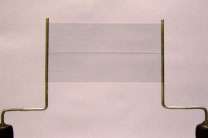'Mirage-effect' helps researchers hide objects (w/ video)

Scientists have created a working cloaking device that not only takes advantage of one of nature's most bizarre phenomenon, but also boasts unique features; it has an 'on and off' switch and is best used underwater.
The researchers, from the University of Texas at Dallas have demonstrated the device's ability to make objects disappear in a fascinating video shown here:
This novel design, presented today in IOP Publishing's journal Nanotechnology, makes use of sheets of carbon nanotubes (CNT) – one-molecule-thick sheets of carbon wrapped up into cylindrical tubes.
CNTs have such unique properties, such as having the density of air but the strength of steel, that they have been extensively studied and put forward for numerous applications; however it is their exceptional ability to conduct heat and transfer it to surrounding areas that makes them an ideal material to exploit the so-called "mirage effect".
The mirage effect, frequently observed in deserts or on long roads in the summer, is an optical phenomenon in which light rays are bent to produce a displaced image of distant objects or the sky.
The most common example of a mirage is when an observer appears to see pools of water on the ground. This occurs because the air near the ground is a lot warmer than the air higher up, causing lights rays to bend upward towards the viewer's eye rather than bounce off the surface.
This results in an image of the sky appearing on the ground which the viewer perceives as water actually reflecting the sky; the brain sees this as a more likely occurrence.
Through electrical stimulation, the transparent sheet of highly aligned CNTs can be easily heated to high temperatures. They then have the ability to transfer that heat to its surrounding areas, causing a steep temperature gradient. Just like a mirage, this steep temperature gradient causes the light rays to bend away from the object concealed behind the device, making it appear invisible.
With this method, it is more practical to demonstrate cloaking underwater as all of the apparatus can be contained in a petri dish. It is the ease with which the CNTs can be heated that gives the device its unique 'on and off' feature.
Lead-author, Dr Ali Aliev, said, "Using these nanotube sheets, concealment can be realized over the entire optical range and rapidly turned on-and-off at will, using either electrical heating or a pulse of electromagnetic radiation.
"The research results also provide useful insights into the optimization of nanotube sheets as thermoacoustic projectors for loud speaker and sonar applications, where sound is produced by heating using an alternating electrical current."
An Institute of Physics spokesperson said, "It is remarkable to see this cloaking device demonstrated in real life and on a workable scale. The array of applications that could arise from this device, besides cloaking, is a testament to the excellent work of the authors."
More information: Mirage effect from thermally modulated transparent carbon nanotube sheets, Ali E Aliev et al 2011 Nanotechnology 22 435704 doi:10.1088/0957-4484/22/43/435704
Abstract
The single-beam mirage effect, also known as photothermal deflection, is studied using a free-standing, highly aligned carbon nanotube aerogel sheet as the heat source. The extremely low thermal capacitance and high heat transfer ability of these transparent forest-drawn carbon nanotube sheets enables high frequency modulation of sheet temperature over an enormous temperature range, thereby providing a sharp, rapidly changing gradient of refractive index in the surrounding liquid or gas. The advantages of temperature modulation using carbon nanotube sheets are multiple: in inert gases the temperature can reach > 2500 K; the obtained frequency range for photothermal modulation is ~ 100 kHz in gases and over 100 Hz in high refractive index liquids; and the heat source is transparent for optical and acoustical waves. Unlike for conventional heat sources for photothermal deflection, the intensity and phase of the thermally modulated beam component linearly depends upon the beam-to-sheet separation over a wide range of distances. This aspect enables convenient measurements of accurate values for thermal diffusivity and the temperature dependence of refractive index for both liquids and gases. The remarkable performance of nanotube sheets suggests possible applications as photo-deflectors and for switchable invisibility cloaks, and provides useful insights into their use as thermoacoustic projectors and sonar. Visibility cloaking is demonstrated in a liquid.
Provided by Institute of Physics




















